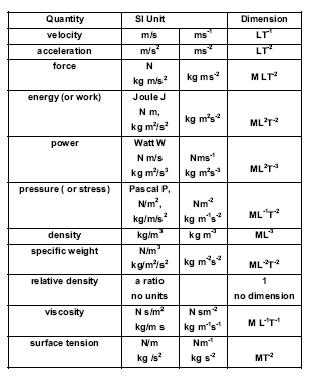Site pages
Current course
Participants
General
MODULE 1. FLUIDS MECHANICS
MODULE 2. PROPERTIES OF FLUIDS
MODULE 3. PRESSURE AND ITS MEASUREMENT
MODULE 4. PASCAL’S LAW
MODULE 5. PRESSURE FORCES ON PLANE AND CURVED SUR...
MODULE 6.
MODULE 7. BUOYANCY, METACENTRE AND METACENTRIC HEI...
MODULE 8. KINEMATICS OF FLUID FLOW
MODULE 9: CIRCULATION AND VORTICITY
MODULE 10.
MODULE 11.
MODULE 12, 13. FLUID DYNAMICS
MODULE 14.
MODULE 15. LAMINAR AND TURBULENT FLOW IN PIPES
MODULE 16. GENERAL EQUATION FOR HEAD LOSS-DARCY EQ...
MODULE 17.
MODULE 18. MAJOR AND MINOR HYDRAULIC LOSSES THROUG...
MODULE 19.
MODULE 20.
MODULE 21. DIMENSIONAL ANALYSIS AND SIMILITUDE
MODULE 22. INTRODUCTION TO FLUID MACHINERY
LESSON 30. DIMENSIONAL ANALYSIS
Dimensions
-
Engineering deals with definite and measured quantities, and so depends on the making of measurements. We must be clear and precise in making these measurements.
-
Engineering entities can be expressed in terms of relatively small number of dimensions.
-
These are length, mass, time and temperature.
-
Application of fluid mechanics in design makes use of experiments results.
-
Results often difficult to interpret.
-
Dimensional analysis provides a strategy for choosing relevant data.
-
Used to help analyze fluid flow. Especially when fluid flow is too complex for mathematical analysis.
The area where dimensional analysis is used are:
design experiments
Informs which measurements are important
Allows most to be obtained from experiment:
e.g. What runs to do. How to interpret.
It depends on the correct identification of variables
Relates these variables together
Doesn’t give the complete answer
Experiments necessary to complete solution
Uses principle of dimensional homogeneity
Give qualitative results which only become quantitative from experimental analysis.
Dimensions and units
-
Any physical situation can be described by familiar properties.
e.g. length, velocity, area, volume, acceleration etc.
-
These are all known as dimensions.
-
Dimensions are of no use without a magnitude.
i.e. a standardised unit e.g metre, kilometre, Kilogram, a yard etc.
-
Dimensions can be measured.
-
Units used to quantify these dimensions.
-
In dimensional analysis we are concerned with the nature of the dimension i.e. its quality not its quantity.
The following common abbreviations are used:
Length [L]
Area [L2]
Mass [M]
Time [θ]
Force [F]
Temperature [T]
Here we will use L, M, T and F.
We can represent all the physical properties we are interested in with three:
L, T and one of M or F
- As either mass (M) of force (F) can be used to represent the other, i.e.
F = MLT-2
M = FT2L-1
We will always use LTM:
This table lists dimensions of some common physical quantities:

The buckingham pi theorem
The buckingham pi theorem puts the ‘method of dimensions’ first proposed by lord rayleigh in his book “the theory of sound” (1877) on a solid theoretical basis, and is based on ideas of matrix algebra and concept of the ‘rank’ of non-square matrices which you may see in math classes. although it is credited to E. Buckingham (1914), in fact, white points out that the theorem has also appeared earlier in independent publications by a. vaschy (1892) and d. riabouchinsky (1911).
The Theorem
Let q1,q2,q3,……qn be n dimensional variables that are physically relevant n a given problem and that are interrelated by an unknown) dimensionally homogeneous set of equations. These can be expressed via a functional relationship of the form:
F(q1,q2,...qn)=0
q1=f(q2,...qn)
If k is the number of fundamental dimensions required to describe the n variables, then there will be k primary variables and the remaining j=(n-k) variables can be expressed as (n-k) dimensionless and independent quantities or pi groups Π1, Π2,…. Πn-k. The functional relationship can thus be reduced to the much more compact form:
ɸ(Π1, Π2,…. Πn-k)=0 or equivalently Π1= ɸ (Π2,…. Πn-k).
Applications of Buckingham pi Theorem
i) Clearly define the problem and think about which variables are important. Identify which is the main variable of interest i.e. q1=f(q2…qn). It is important to think physically about the problem. Are there any constraints; i.e. ‘can I vary all of these variables independently’;
e.g. weight of an object Fw=ρgl3 (only two of these are independent, unless g is also variable)
ii) Express each of n variable in terms of its fundamental dimensions, {MLTθ} or {FLTθ}It is often useful to use one system to do problem, and then check that groups you obtain are dimensionless by converting to other system.
iii) Determine the number of Pi groups j=n-k, where k is the number of reference dimensions and select k primary or repeating variables. Typically pick variables which characterize the fluid properties, flow geometry, flow rate…
iv) Form j dimensionless Π groups and check that they are all indeed dimensionless.
v) Express result in form Π1= ɸ1 (Π2,…. Πn-k) where Π1 contains the quantity of interest and interpret your result physically!
vi) Make sure that your groups are indeed independent; i.e. can I vary one and keep others constant.
vii) Compare with experimental data!